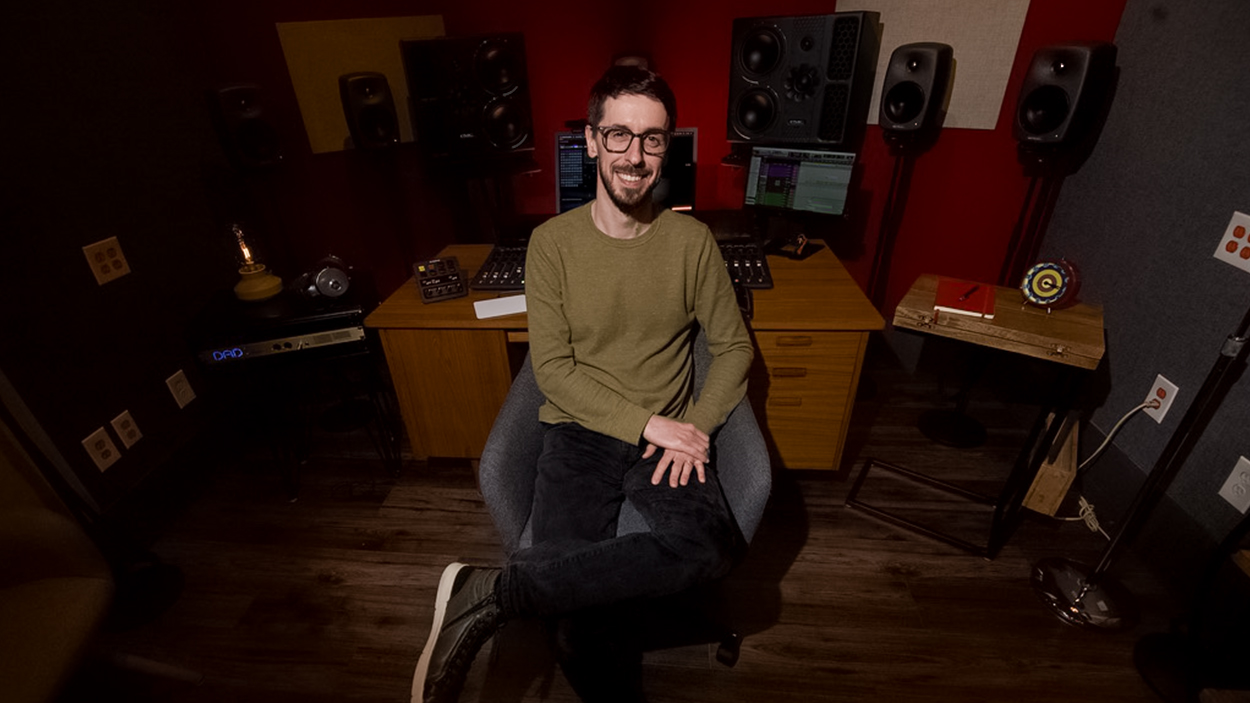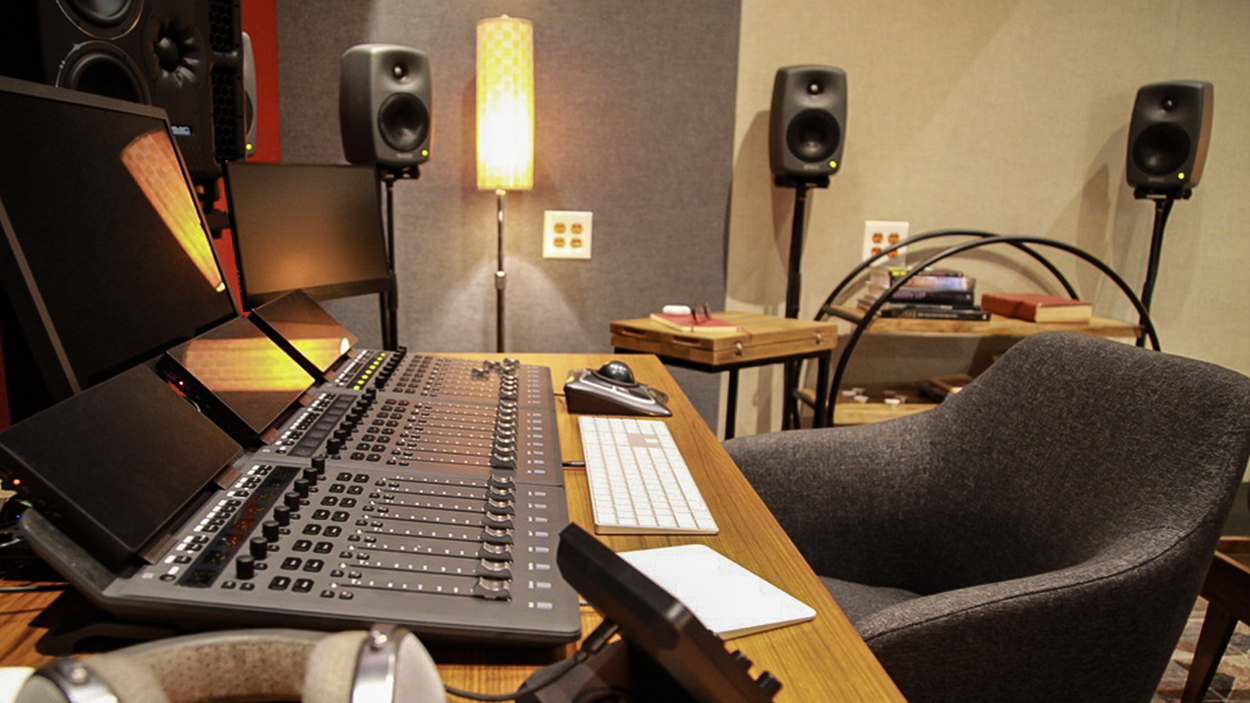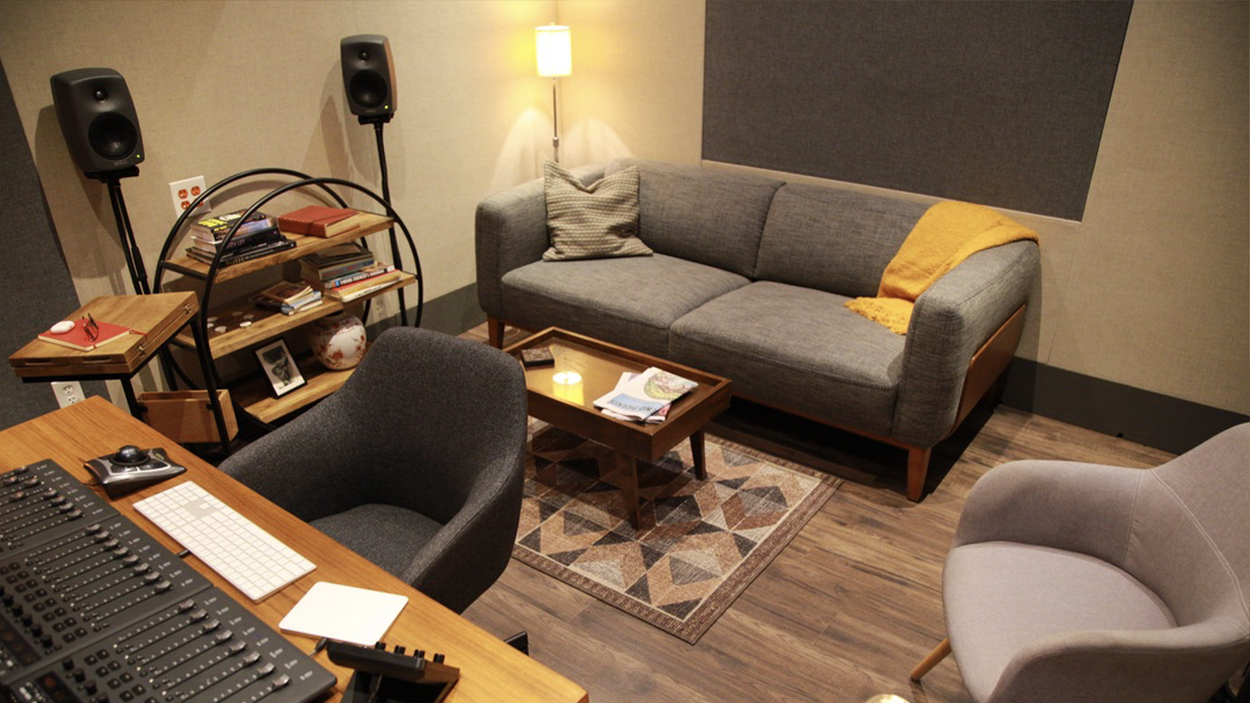Immersive Talk with Alex Gamble
Can you please introduce yourself, tell us your job title, and tell us a little bit about what you do, and how you ended up doing it!
I’m Alex Gamble, a music mixing engineer based in Toronto, Canada. I’ve been very lucky to work with some amazing artists over the years. People like Alex Warren, FKA Twigs, Debby Friday, and Envy of None are a few projects I’m really proud of lately.
I guess you could say I’ve taken the “traditional” route to get here, although the path I took is becoming more rare these days! I got my start as an intern and assistant, and eventually in-house engineer at a studio. I did that in my early years, and I’ve carried that foundation of skills with me as I’ve built things up as a freelancer, and eventually a full time mix engineer today.
Can you tell us about your studio space? Where its located, any history of the building, the approximate size of the studio?
The studio I’m mixing in now is actually inside of the first studio I interned at, which was such a full circle moment. The space is called Union Sound Company and it’s in Toronto, Canada. In addition to the mix room that I occupy full time, Union also has one of the best multitrack recording facilities in Canada. Their tracking room is built around a vintage Neve console and a gear collection that’s about as good as it gets.
When I joined on with Union back in 2014, the studio wasn’t even built yet. Constructing this mix room was actually the first paid gig they offered me after I interned with them. My blood, sweat, and tears are all over this place. Knowing the studio so intimately was handy when I moved my business back here a decade later, because a lot of modifications needed to happen to get Dolby Atmos up and running.

Can you give an overview of the key equipment you use in the studio – consoles/ DAW/processors/sound sources/signal distribution etc?
For this studio, I decided to try an experiment and I’ve made the room one hundred percent digital. In fact, the only analog cable in the entire room is the one connecting my headphones! I never thought I’d be surrounded by more ethernet cables than analog audio cables, but here I am.
Doing it this way ties in with my philosophy as of late which is to focus deeply on listening. Taking away the racks of gear actually removed a lot of distractions for me. It leaves me with no choice but to sit and listen attentively, and in mixing that’s what matters the most. In this room, I’m listening more deeply than I ever have and I’ve never felt better about the work I’m producing.
Bearing all that in mind, the monitor choice was singlehandedly the most important piece of gear I had to select for this room. There was a lot of listening and deliberation before I made the call to go with Genelec for my immersive speakers. I love them, and everyone that comes in here feels the same way.
The brain of the whole setup is a DAD / NTP AX Center interface. This acts as my hub for signal routing and is also my source selector and monitor controller. One MADI cable comes off the back of it, which breaks out into individual AES channels that go to the monitors. There’s no D to A conversion anywhere in the chain until sound reaches the speakers.
I control my mixes using three Avid S1’s connected to Pro Tools Ultimate. I’ve gotten to know the workflow on these surfaces really well, to the point where it feels like playing an instrument now.
What type of work do you do in your studio?
Most of the work I do in here involves mixing and mastering. I’ve been really lucky to get connected with some awesome artists and labels who enjoy my work and keep sending projects my way. Dolby Atmos has definitely become a staple, but the art of making music sound great in 2-channel stereo is also important work that I do every day. The most important musical ideas need to work in 2 speakers, or even one speaker, if they’re going to work at all.
Is there a particular Immersive format you specialize in?
I’ve been working in Atmos almost exclusively since getting into immersive audio. I’ve done the odd 5.1 project as well.
I’ve also been quite fortunate to have engineered a Dolby Atmos album for listening to in a cinematic environment. Although it’s technically the same format, a lot of different considerations need to be made when you know something is going to be experienced in a cinema. It’s a very terrific album called Immersed by an artist named Justin Gray, who also happens to be one of the pioneering engineers and producers in the format himself.

How and when did you become interested in immersive audio?
In 2021, I was very lucky to be working with a really forward thinking artist at the time named Selina Martin. When Apple went online with Dolby Atmos, the first thing I did was I got the tools running and experimented with her record. Hearing how it created space and dimension in her music opened up a whole new creative world for both of us. We scrapped the idea of mixing it in stereo, and finished the album in Atmos. It still stands as one of my favourite Atmos mixes I’ve done, which is largely a credit to her great intuition with such a brand new tool at the time. For me, everything kind of snowballed from there and I became really committed to producing these types of listening experiences for people going forward.
What made you finally equip your studio for immersive, and can you describe how you did the upgrade? If you worked with any external people or had work done on the studio, can you provide some details?
When we did Selina’s record, we did it in headphones because that’s all we had access to. We eventually ended up renting an immersive studio to print the final mixes, and after that I was hooked. I immediately put the wheels in motion to equip my shared studio space at the time, Raventape Music Room, with Dolby Atmos.
That was in 2021, and the equipment and expertise to set a room up weren’t close to where they are today. We hired Signal Acoustics for the physical install but there were no local resources for calibrating a system, which meant I had to learn it myself. Dolby was kind enough to guide me along the way remotely, and I love how the room turned out. It’s still up and running and has been consistently upgraded as immersive gear gets better. Robbie Grunwald and Beau Cassidy are two engineers making some great stuff out of there.
That experience willed me into really understanding what goes into setting up an Atmos room. This skill was useful when it came time to move into Union Sound. It meant that I knew exactly what I wanted, and how I wanted to do it.
Now that you are working in immersive, can you describe how you approach it, how it differs from stereo mixing, and what creative opportunities/challenges it presents?
I’ve played around with a lot of approaches since getting into this format. What I’ve ultimately settled on is that objects are king. They consistently give me the best sounding results, especially when I move the mix to other systems and to consumer devices.
Doing things this way though has necessitated a much different approach compared with stereo. Particularly when it comes to bus processing, there just isn’t an easy way to do it. The way I approach this is to take extra time and effort upfront to get the individual sounds perfect without any bus processing. I don’t do any immersive panning until I feel confident that the sounds are right. In many cases I might have access to a completed stereo master by myself or another engineer, which helps provide a blueprint for this.
A keen ear and a lot of trial and error go a long way in doing this, because many of the same techniques I use in stereo won’t feel right to me in immersive. One example is the idea of “glue” in a mix. Bus compression works great for this in stereo, but in Atmos it rarely makes sense to have a snare drum ducking an instrument on the opposite side of the room, unless there's clear musical intent behind the effect.
For that reason, my glue in an immersive mix often comes in the form of short-tail, and barely-noticeable immersive reverbs. My favourite one is Liquidsonics Cinematic Rooms. There’s a patch in there called “Ambience One” that I love for this. If you listen to one of my mixes you shouldn’t even notice it, and that’s the point. It’s just a bit of 3D “connective tissue”. It allows me to create these massive soundstages that don’t leave isolated sounds feeling naked or stranded, even when they’re panned very extremely relative to each other. It makes bolder choices feel less out of place, and leads to bigger and more engaging mixes.
There are a number of technical differences like this that I’ve found. My best advice is to focus more on what you’re trying to achieve, and less on the gear you’re used to using to achieve it. You’ll be surprised at what works if you really listen, and detach yourself from your old habits.

Can you describe your Genelec monitoring system (format, models etc)? Can you tell us why you chose Genelec, and how the monitoring system helps you to work in immersive?
I’m running a 9.1.4 configuration of 8330A SAM speakers, and a 7360A SAM subwoofer. My first Atmos system was a 7.1.4, but adding the wide speakers to complete the “9” setup is paying off. Now that I’ve heard it, I can’t go back.
I did a lot of listening to a lot of different speakers before choosing to go with a Genelec setup for my immersive rig. I chose them because they have a huge sound for their physical size, are incredibly pleasing to listen to, and have a billion different ways to mount them to the walls and ceiling. I can’t stress enough how important the mounting options are! Most importantly, they’re amazingly detailed and make you work hard to get things right. I hear all the transient, frequency, and imaging details I need to hear when I’m making critical decisions in immersive audio.
The subwoofer is one of the best I’ve ever heard too. It’s actually been quite a revelation for me. My low end is translating great because I’m hearing it in so much detail in here.
Did you use GLM (Genelec Loudspeaker Manager) to calibrate your system, and can you describe what difference that makes?
Yes I did. I actually found myself in a fortunate position of having multiple options at my disposal to calibrate this system, and I tried them all. In the end, GLM produced the best imaging and sound profile for these speakers. You obviously know your hardware well!
One of the things I especially love about GLM is that it doesn’t try to overcorrect nulls in the room using EQ boosts. Other systems don’t approach this like Genelec does, and they just make the speaker work harder than it needs to for very little improvement. GLM recognizes this, and does things the right way.
I also appreciate all of the online resources you have available for GLM. I was expecting a few quick walkthrough videos, but instead there was an hour and a half worth of lessons on acoustic physics before you even begin talking about the software. I loved that! You’ve gone out of your way to empower your users with knowledge and skills, and then GLM takes it the rest of the way.
Can you list some of the immersive projects you have worked on recently, and is your immersive room bringing you new business? Was it a good commercial decision?
Hands down, getting into immersive audio is the best decision I’ve made in my career. It’s opened so many doors for me. Just this year, a song I did the immersive mix for went number one on the Billboard Hot 100 chart (“Ordinary” by Alex Warren). I’ve done mixes for some of my favourite artists like FKA Twigs, Noga Erez, and rap legend Gucci Mane.
I’ve sat in this room collaborating with some of my musical heroes like Alex Lifeson for his new band Envy of None. Their record is a wild ride actually. The vocalist in that band, Maiah Wynne, is so talented at layering her voice. It feels like her aesthetic was always made for immersive audio, and she really shines in the mixes we put together.
I simply can’t overstate what immersive mixing has done in terms of building my business, but what I truly value is the experience of being in the room with an artist listening to their mix in Atmos. Something about being in the center of the music triggers emotions in a different way. Many people have expressed that it reconnects them with the feelings they were going through when they conceived their music, which I think is really special. It’s incredibly gratifying to have learned a tool that has the potential to move people emotionally in that way.
How do you see the future of immersive audio over the next few years?
It’s actually crazy that four years ago, I needed two computers and a huge rack of gear to make Dolby Atmos work. Today my whole system is on one Mac, and one rack-unit worth of gear. Things have moved forward quickly in terms of creative tools for producers and engineers. The next frontier in my opinion is finding accessible ways for consumers to experience what I’m making in this space. Cars are starting to adopt it, and Cadillac specifically has gone above and beyond in designing their immersive system. I think there’s a lot of promise in the automotive field for this.
In terms of long term direction, who knows what the future holds. I firmly believe that object-based audio is such a strong pillar upon which to build new and innovative ways to experience sound. All I do is tell the sound where to go, and the speakers make the magic happen! I can’t wait to learn about what new technologies come around that translate the experiences myself, and the artists I work with are creating.



